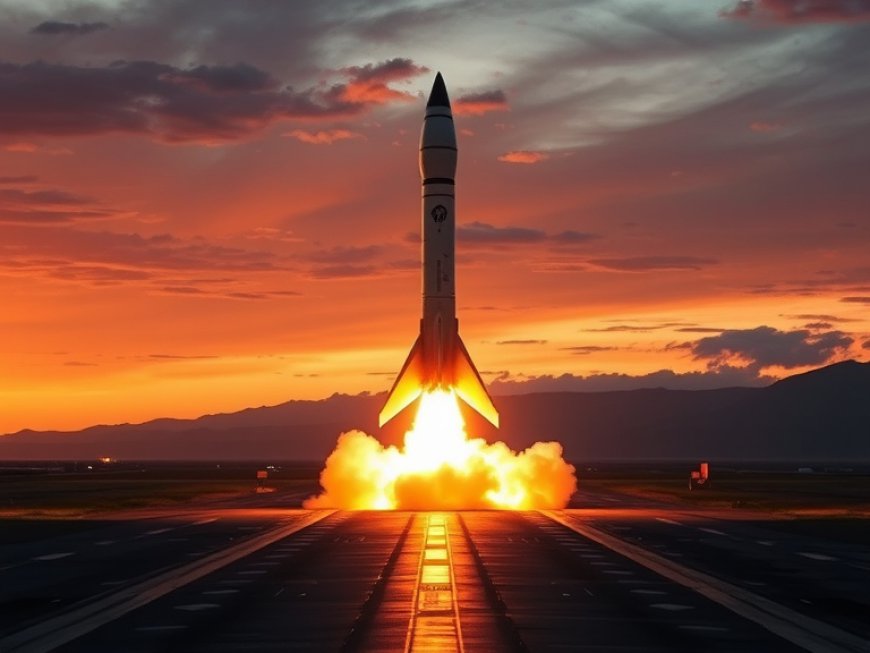U.S. Hypersonic Nuclear Missile Test In The Election Hours
On U.S. Election Day, the U.S. tested a hypersonic nuclear missile, sparking global concerns. Learn about the missile’s features, timing, and its potential impact on global security and diplomacy.


Introduction
On U.S. Election Day, the United States tested a powerful hypersonic, nuclear-capable missile, capturing attention worldwide and raising concerns among key adversaries, including China, Russia, and Iran. This missile, capable of reaching any global location within 30 minutes, represents a major advancement in modern defense technology. Here, we delve into its features, timing, and the broader implications of this test for global security and diplomacy.
What Is a Hypersonic Nuclear Missile?
A hypersonic missile is a weapon that travels at speeds over Mach 5, or five times the speed of sound, equivalent to about 3,800 miles per hour. In this recent test, the U.S. missile reportedly reached Mach 20, or 15,000 miles per hour, making it incredibly fast and nearly impossible for current defense systems to intercept.
Top 10 Military Drones launched In (2025-2027)
Types of Hypersonic Missiles
- Hypersonic Glide Vehicles (HGVs): These missiles are launched on a rocket and glide back at hypersonic speeds. They’re highly maneuverable, making them hard to predict and intercept.
- Hypersonic Cruise Missiles: Powered by high-speed engines like scramjets, these missiles stay within the atmosphere, maintaining hypersonic speed.
The U.S. test involved a hypersonic missile equipped for nuclear capability, adding a formidable weapon to its defense arsenal.
Key Features of the U.S. Hypersonic Missile
- Extreme Speed: This missile can reach speeds of 15,000 miles per hour, hitting targets within 30 minutes. Conventional cruise missiles typically max out at about 700 miles per hour.
- Unpredictable Path: With advanced maneuverability, the missile can evade radar and missile defenses more effectively than traditional ballistic missiles.
- Nuclear Capability: This missile can carry a nuclear warhead, amplifying its role as a deterrent in the U.S. defense strategy, especially against nations with advanced defenses.
Election Day Test and Political Implications
The timing of this test on Election Day appears intentional, underscoring U.S. commitment to cutting-edge military technology during a politically charged time.
- Strengthening Defense Priorities: The Election Day test signifies the U.S. focus on long-term defense strategies.
- Signaling Allies and Adversaries: Testing this missile on a prominent day signals to both allies and adversaries the U.S.’s commitment to maintaining its defense technology leadership.
- Domestic Reassurance: Displaying advancements in defense technology can reinforce national security importance to the American public during an election cycle.
Global Reactions from Major Powers
The U.S. test has raised concerns from global powers, particularly China, Russia, and Iran.
- China: China, actively developing its hypersonic capabilities, views this test as destabilizing. Officials warn of an arms race, suggesting this technology may increase regional tensions.
- Russia: Already equipped with hypersonic weapons like the Avangard glide vehicle and Zircon cruise missile, Russia sees U.S. advancements as a challenge. Russian officials argue that militarizing hypersonic technology threatens stability and could lead to an arms race.
- Iran: Iran considers this missile a regional threat, especially if deployed in the Middle East. Iranian leaders warn that such developments could worsen tensions, as Iran faces existing pressure regarding its nuclear program.
Other countries, including Pakistan and North Korea, share similar concerns, cautioning that hypersonic technology could shift global power balances and escalate military conflicts.
The Growing Hypersonic Arms Race
The introduction of hypersonic missiles has sparked a new arms race as nations seek to develop or defend against this advanced technology.
- Interception Challenges: Existing missile defenses struggle to counter hypersonic missiles due to their extreme speed, low altitude, and agility.
- Research and Countermeasures: The U.S. and its allies are investing in advanced radar and satellite tracking to enhance detection of hypersonic threats.
- Increased Defense Budgets: Many nations are allocating significant resources to develop hypersonic technologies or create new defenses.
Impact of Hypersonic Missiles on Global Security
Hypersonic missiles disrupt traditional defense dynamics, with several implications for global security.
- Reduced Response Time: With the capability to reach targets globally within 30 minutes, hypersonic missiles demand faster response times, increasing the potential for preemptive strikes.
- Global Deterrence Shifts: Hypersonic missile development will reshape defense strategies, as nations prepare to counter such threats.
- Risk of Miscalculation: The extreme speed of hypersonic missiles leaves limited time for decision-making during crises, raising the likelihood of unintended escalation.
The Future of Hypersonic Missile Development and Diplomacy
This test has major implications for international diplomacy, particularly regarding U.S. relations with major adversaries.
- Potential for New Treaties: Experts suggest that hypersonic weapons may prompt the need for updated arms control treaties to prevent an unchecked arms race.
- Pressure on Defense Budgets: As hypersonic capabilities grow, countries may feel pressured to increase budgets for both offensive and defensive systems.
- Regional Tensions: Hypersonic technology could impact conflict zones where tensions are high, potentially emboldening nations with hypersonic capabilities.
Conclusion
The U.S. hypersonic missile test on Election Day has heightened discussions around global security, advanced technology, and international diplomacy. Capable of reaching any target globally within 30 minutes, this missile represents a significant leap in warfare capability. However, its implications extend beyond military power to impact global stability and strategic decisions across nations.
As countries rush to either develop hypersonic weapons or defenses, the urgency for diplomacy and arms control measures grows. The world is closely monitoring these advancements, recognizing that hypersonic technology could reshape geopolitical dynamics, defense strategies, and the future trajectory of warfare.
